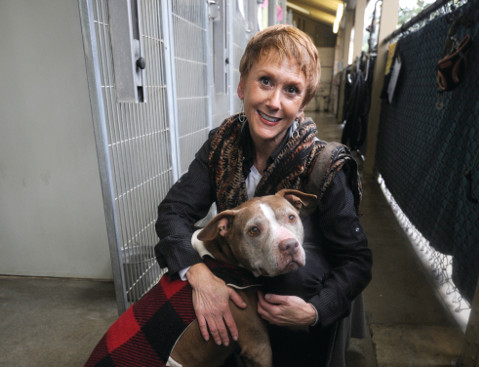County Shelter Makes Major Improvements
But Budget Woes Loom on the Horizon

Santa Barbara is a dog town. Beaches, movie theaters, shops — domesticated canines are everywhere. At bars downtown, it is not unusual to find four-legged pups awkwardly sitting on the next stool. When City Council discusses no-leash zones, there are few empty seats in the pews.
These days, the county pound on Patterson Avenue looks more like a boutique pet shop full of groomed mutts patiently awaiting a new owner. But that has not always been the case. Just five years ago, more than 80 dogs — twice the number of available cages — packed into the shelter on any given day. This week, there were 32 dogs.
One of them was Courage, a black-and-white pit bull, who came from the Lompoc shelter with a skin infection so horrendous his owner could have faced criminal charges. “In the past, [Courage] would have maybe been euthanized,” explained Dori Villalon, the shelter’s operations manager, one of five new positions that the county created last year to improve a department long plagued by dysfunction and understaffing.
After several months of treatment, the 2-year-old pit bull has almost entirely recovered. A volunteer dog communicator recently talked to Courage, Villalon explained, and discovered he would like to be adopted by a soulful person, perhaps someone who practices yoga. So they decided to host a yoga class next Saturday in hopes an attendee would adopt him. Such creativity is quite a departure from a place often associated with detention.
“I’ve seen a pretty remarkable shift,” said Angela Walters Rockwell, who is the executive director of ASAP (Animal Shelter Assistance Program), which buttresses the county shelter by taking in nearly 1,000 stray cats every year. “The change in all of this has come out of a tremendous amount of work and progress. We are seeing the benefits.”
But looming budget woes, precipitated by the fact the county must increase its employee pension contributions by about $11 million more next year, are cause for concern for all county departments. “I don’t think ‘crisis’ is too big of a word,” Villalon said. “We’ve been operating toward building. Nobody wants to go backward. It has really thrown us for a loop.”
Animal advocates say success stories like Courage’s warrant the resources for additional staffers. But the fact fewer dogs are languishing in the pound makes some critics believe the new positions are superfluous. “It’s easy to say we have fewer dogs; we don’t need money or resources,” said Rockwell.
It remains to be seen how tightly the budget must be squeezed. On the chopping block could be the job of Community Outreach Coordinator; the person in that position recently left the shelter for a higher-ranking post in Texas. The coordinator’s innovative marketing efforts, observers said, is one key reason the shelter’s dog population has steadily decreased in recent years. Other reasons include more affordable spay and neuter programs, operational improvements to prevent overcrowding, and “conversational” adoption, a new approach that focuses on matching a potential adopter with the right animal.
Likewise, where shelter employees used to check with landlords to make sure they allowed their tenants to have pets, Villalon now sometimes calls landlords who prohibit animals to try to convince them to relax their policies.
The tricky part of the Animal Services story is that nonprofit volunteers play a vital role. They augment the department so greatly that it almost semi-privatized. In fact, a hybrid model in which nonprofits are contracted has been a topic at governance oversight committee meetings.
But volunteers are not harmonious as they are split up among nonprofits. The dog volunteers are only loosely organized, and they have varying degrees of hands-on experience. Contention among some volunteers and staffers at county supervisorial hearings, if nothing else, underscores the notion that Santa Barbarans care immensely about their pets.
In fact, Santa Barbara may be a place where people love their dogs, but perhaps to a point where owners allow them to behave too freely. “They need to be under better control,” Villalon said. In recent weeks, she has seen a case of an unleashed rottweiler attacking horses being ridden at Loon Point Beach in Carpinteria. Another dog killed a 16-year-old dog being held in his owner’s arms on the sidewalk in Goleta. In less than a year, Villalon has overseen six hearings; the majority of dogs were released as restricted. Two years ago, the county updated its dangerous dog ordinance after two infamous dogs, Daisy and Duke, killed three cats in Orcutt.
For Villalon, who has been a change agent of sorts at several animal shelters in Cleveland and Colorado, among other places, the spirited passion people have for animals in an affluent place is a “luxury.” It’s like “Maslow’s hierarchy,” she said: A person’s basic physical needs must be satisfied before emotional ones can be met. “I’ve seen when people are just trying to get through the day,” she said.



